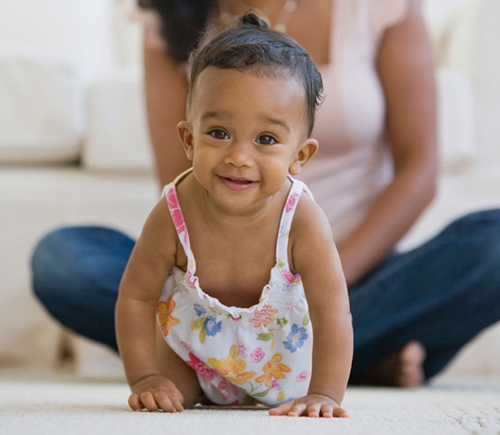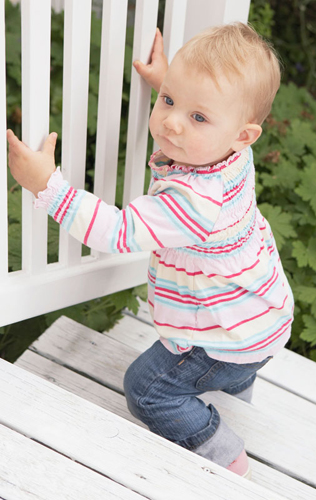| Q: | My baby is crawling everywhere. Should I be worried about hygiene? | | A: | When your child is on the move and putting everything he finds into his mouth, hygiene can be quite a challenge. It is best to try to prevent him from putting leaves and dirt into his mouth, especially in the playground or park. At home, as long as you keep your floors moderately clean, a little bit of dirt will not hurt him and can actually help to build up immunity against infection. In fact, according to the latest research, though your baby may have a few more colds now than his peers living in spotless environments, he may be less likely to suffer chronic problems with asthma and allergies later in life. This has become known as the “hygiene hypothesis.” Try to use safe cleaning fluids rather than toxic bleaches. If you are worried, rather than denying your child the freedom to roam and explore for fear of getting dirty, make a play space by covering the floor or ground with a large blanket. This will give you peace of mind when you cannot be sure the surface is clean enough. |
| Q: | My son has a never-ending curiosity, but I’ve run out of suitable, safe play ideas. Any tips? | | A: | Your son’s desire to be “into everything” allows him to build up knowledge and experience of the world. Encourage curiosity by creating your own treasure basket, such as a plastic bowl or soft drawstring bag, filled with household objects of different shapes and textures. Include objects such as a wooden spoon, a lemon or orange, plastic containers, some different fabrics, and some noisy toys such as rattles. Change the items regularly to keep his interest. Another favorite, once your baby is mobile, is to let him explore one of the kitchen cupboards. Pile it full of plasticware such as containers, tumblers, and mixing spoons, and let him pull everything out. You might label it “his” cupboard to prevent him learning that all the kitchen cupboards are for him to play with. Remember, he will be putting everything in his mouth to taste and feel, so supervise him at all times and don’t include anything sharp, with rough edges, or small enough to cause choking. |
| Q: | Can I take my young baby to the local swimming pool? | | A: | Babies have a built-in affinity with water, and introducing her to a swimming pool can be a safe, stimulating experience. Stick to the baby/toddler areas, which are usually warm and shallow and not too loud and splashy. Bringing along a familiar bath toy may help make the transition from bath to pool. Start with shortish periods of time (20 minutes) and build your time up gradually, always ensuring that your baby is not getting cold or tired. Allow her to enjoy her natural confidence in the water while holding her securely. If you can be calm and confident, she will have a wonderful time. If you are unsure of water and swimming yourself, try joining a moms and babies swimming course to help you manage your own anxieties. |
| Q: | Do children and pets mix? | | A: | If you already have a pet before you have your baby, you have to think carefully about the needs of both and be prepared for your pet to feel a bit neglected. This can mean that a dependable family dog can behave in uncharacteristic ways, including being aggressive. This is rare, but it is essential that you never leave your baby alone with a pet. If you have a choice, it is probably better to wait a while before getting a pet, until your toddler is steady on her feet, and not putting everything in her mouth. Pets do present a wonderful opportunity to teach your child about kindness, gentleness, and caring for others. Even babies need to learn not to pull tails or interfere with feeding time. Teach them caution around animals, especially unfamiliar dogs. Don’t let animals lick your baby’s face, and protect her against the possibility of dog and cat feces being passed from hands to mouths to prevent dangerous infections. |
| Q: | How can I teach my child about safety without frightening him? | | A: | It is never too early to start to teach your child the difference between what is safe and what is not. This is not to instill unnecessary fear and caution in him, rather to clearly point out things that are “hot” or “sore” and show him how to respond to them appropriately. Learning not to touch at an early age is an important lesson that is always best backed up by safety equipment, so that no real harm comes to youngsters who need to find out for themselves. Part of teaching safety in a measured way is making sure that you are a good role model. Your child will try to copy the things he sees you do, so don’t balance on rickety chairs to reach the top shelf in front of him, or cross the road when a red light is showing. If you are overly fearful and cautious in certain situations, however, your child will copy that too. Studies of 12-month-olds have shown that when a child is unsure whether there is danger or not, he will look to his mother for cues and will respond accordingly. Although you do want to teach him sensible caution, you may not want him to grow up thinking the world is treacherous, so it may be worth putting on a brave face in your own feared situations and teaching your child the response you wish you had. |
Safety-consciousness or overprotection?Helping your child feel safe and secure and, as a consequence, facilitating his easy development toward independence, is a step-by-step process. His early fears of being left alone, of strangers and of the unknown, engender great distress. Your role as parent is to comfort and diminish the enormity of the fears. In the case of being left or separation anxiety, you say, “I was just in the other room, I wouldn’t leave you” and make sure that you’re true to your word. His distress will gradually disappear, and soon he’ll learn to trust that you will return and happily be able to function in your absence. As he grows into toddlerhood and beyond, your explanation of things such as loud noises or looming shadows will help him learn to contain his fear, increasing his confidence and allowing him to explore his world with impunity. Comfort zoneYour child will use you as a base to explore from. A “securely attached” child (meaning she has strong bonds with you) will find this easier and be more willing to leave your side. 
Keeping an eye outClose supervision around potential dangers, such as stairs, is needed since your child will be quick to explore. 
|